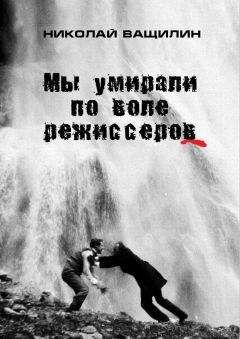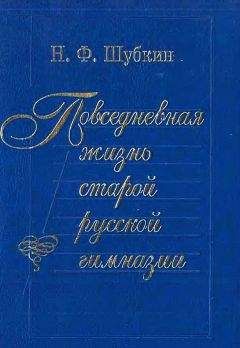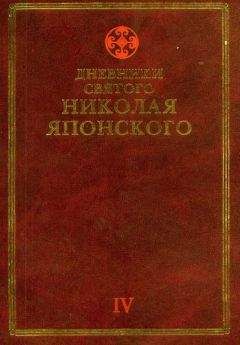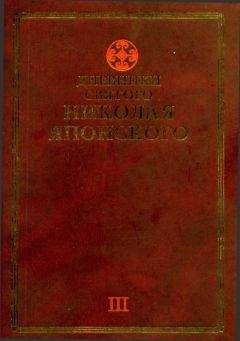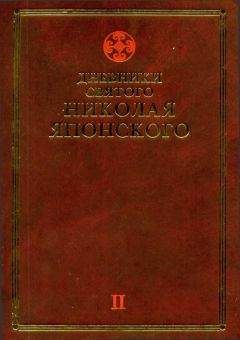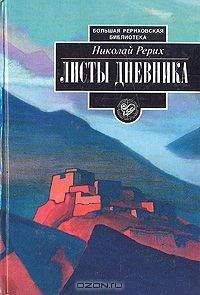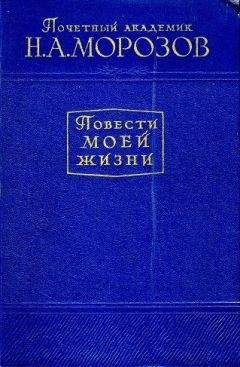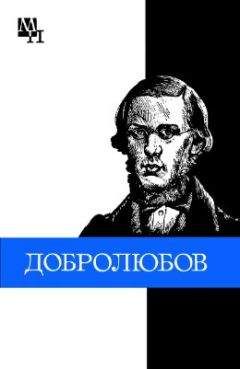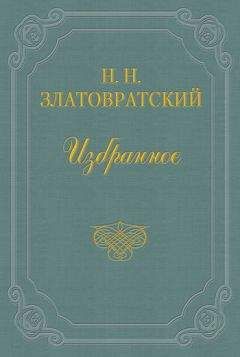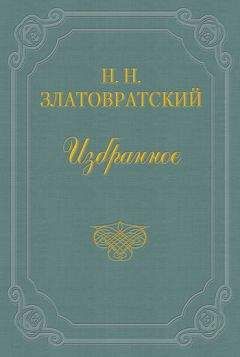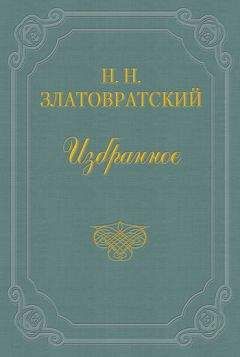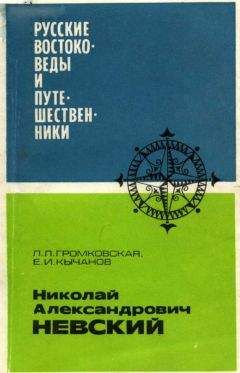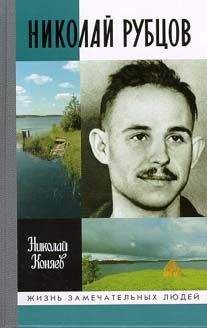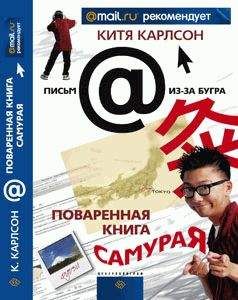Николай Японский - Дневники св. Николая Японского. Том Ι
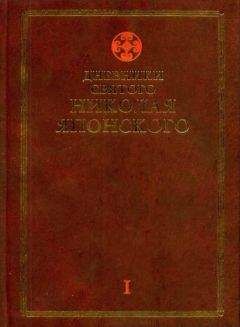
Скачивание начинается... Если скачивание не началось автоматически, пожалуйста нажмите на эту ссылку.
Жалоба
Напишите нам, и мы в срочном порядке примем меры.
Описание книги "Дневники св. Николая Японского. Том Ι"
Описание и краткое содержание "Дневники св. Николая Японского. Том Ι" читать бесплатно онлайн.
Настоящее пятитомное издание представляет собой первую полную публикацию огромного дневника, который на протяжении всей своей жизни вел основатель русской Православной миссии в Японии архиепископ Николай Японский (1836–1912). Приехав в Японию в возрасте 24 лет, о. Николай в течение пятидесяти лет занимался миссионерской деятельностью. Им были основаны семинария, школы богословия, иконописная мастерская. В совершенстве изучив японский язык, он перевел для своих прихожан–японцев Священное Писание. Когда он скончался, японская православная община насчитывала 34000 человек, и это его прямая заслуга. Помимо миссионерской деятельности о. Николай проявил себя и как незаурядный ученый, оставивший в своих дневниках уникальные этнографические материалы о Японии, зафиксированные им во время своих многочисленных путешествий по стране — от деревни к деревне, где жила его паства. В Японии отец Николай пользовался и пользуется необычайной известностью, а его заслуги — всенародным признанием. Интерес к нему появился и в России, особенно после его канонизации русской Православной церковью (10 апреля 1970 г.).
Первый том дневников охватывает период с 1870 по 1880 гг.
Под редакцией Кэнноскэ Накамура
Исходный pdf - http://mirknig.com/knigi/religiya/1181616647-dnevniki-sv-nikolaya-yaponskogotom-1.html
Настоящее полное издание «Дневников святого Николая Японского» смогло увидеть свет благодаря содействию большого количества людей, перечисленных выше, в том числе и составителей и всех оказавших помощь в выпуске «Дневников святого Николая Японского» издания Хоккайдского Университета. Выражаем всем им глубокую признательность.
Мы также от всего сердца благодарны нашей супруге Эцуко Накамура, которая самоотверженно помогала на всех этапах работы по изданию «Дневников» на протяжении 24 лете момента обнаружения их в 1979 году. Без ее понимания и поддержки эта книга не появилась бы на свет.
Мы выражаем здесь глубокую признательность директору РГИА А. Р. Соколову, проявившему понимание значения публикации Дневников св. Николая Японского для международных японо–российских научных исследований и согласившемуся на настоящее издание.
В заключение мы выражаем глубокую благодарность Святейшему Патриарху Московскому и всея Руси Алексию II и Высокопреосвященнейшему Даниилу, Архиепископу Токийскому и Митрополиту всея Японии, с благословения которых издана настоящая книга.
Желаем, чтобы «Дневники св. Николая Японского» внесли свой вклад в укрепление взаимопонимания между Японией и Россией.
Кэнноскэ Накамура
Март 2003 года
PREFACE
Iosif Antonovich Goshkevich
By the middle of 19th century the Tokugawa shogunate was being forced to terminate its Sakoku (’National Seclusion’), which had been adopted in 1639 and maintained ever since. On the 8th of July, 1853, the American Commodore Matthew C. Perry arrived off the coast of Japan with a squadron of four ships, which frightened the Japanese people. Perry demanded that the Japanese government conclude a treaty of amity with the United States. It was the sort of strong pressure from outside which Japan had never experienced for a long time. As a result, in March, 1854, the Kanagawa Treaty of Peace and Amity between the United States and Japan was signed. In August, 1856, the first American consul–general, Townsend Harris, arrived in Japan, reopening the country to the world.
One month and a half after Perry’s visit, on August 22, 1853, the Russian Vice–Admiral Evfimii V. Putiatin arrived at Nagasaki on the flag ship Pallada, accompanied by four other vessels. And next year (1854) he came to Japan again with a single vessel, the frigate Diana. Although Putiatin negotiated with the representatives of the Japanese government peacefully, he had been assigned a task similar to that of Perry — to initiate relations with Japan and to reopen the country.
For the Japanese people, the Russian delegation was also perceived as frightening Kurofune (’black ships’) from abroad. However, in Feburuary, 1855, the Russo–Japanese Treaty of Amity was concluded. Later (in August, 1858) the Russo–Japanese Treaty of Friendship and Commerce was signed.
In September, 1858, Iosif Antonovich Goshkevich (the first Russian consular representative) arrived in Hakodate with his staff. He had previously visited Japan in 1854–1855 as a Chinese–language interpreter for the Russian expeditions under Putiatin.
In July, 1860, Vasilii Makhov, chaplain of the consular chapel, returned to Russia due to ill health. Goshkevich had sent in 1859 through the Asiatic Department of the Ministry of Foreign Affairs a letter requesting the Holy Synod in Russia to send to Hakodate a successor to the post of chaplain. In the letter he wrote that «the chaplain of our church will also be able to promote the propagation of Christianity in Japan». It is worthy of notice that Goshkevich saw the prospect of missionary work in Japan as early as this time, when Christianity was still strictly prohibited throughout Japan.
Goshkevich was the son of a village priest. He was educated at the seminary in Minsk, and graduated from the Theological Academy in St. Petersburg. He
worked in Peking as a member of the Russian Orthodox Mission for nearly 10 years. Upon his return to Russia, he became a member of the Asiatic Department of the Russian Foreign Ministry and (as previously noted) served as the Chinese interpreter for Putiatin during the Russian expeditions to Japan. In Goshkevich, we can find the genesis of Russian Orthodox missionary work in Japan. When he was appointed as the first Russian consular representative in Japan, Goshkevich must have expected that the prohibition of Christianity there would be removed in the near future.
When Vasilii Makhov was about to leave for Russia, Goshkevich must have sensed the opportunity to realize his long–cherished dream. He asked the Holy Synod to send not a chaplain who would merely handle church functions for the consular staff, but a highly–educated missionary who could preach the gospel to the Japanese people.
Goshkevich wrote in the letter to the Holy Synod that the next chaplain should be «one who had completed the course of the theological academy and will be competent not only in ecclesiastical functions, but in scholarly activities as well, and who will present an excellent example of our clergymen through his private life, both to the Japanese and foreigners living here». (RGIA, f. 796, ed. khr. 572, d. 1859).
In response to this request, there arrived in Hakodate from St. Petersburg the 25 year–old Hieromonk Nikolai. To the great good fortune for the Japanese, this young priest was equipped with all the abilities that Goshkevich had asked for, though this was not proved for certain until Nikolai began his work. It can be said that Goshkevich recognized that the Japanese people were fairly cultivated, and thus endeavored to bring to Japan the sort of excellent missionary who was qualified to teach them Christian doctrine.[4]
Goshkevich returned to Russia in 1865, worked in the Asiatic Department of the Russian Foreign Ministry and retired from public service in 1867. About that time, he informed the Orthodox Missionary Committee that Hieromonk Nikolai had secretly begun to engage in missionary activity in Hakodate, and arranged for Nikolai to receive financial assistance from the Committee. Moskovskie vedomosti (The Moscow Herald) of October 8 (20), 1867, reported that «the Board of the Orthodox Missionary Committee received very encouraging news of the work of Hieromonk Nikolai Kasatkin in Japan… Can we leave this respectable Hieromonk without help? In western countries everywhere these missionaries enjoy the general support of the people. We hope that our society will also respond to the appeal by the Committee for subscription. Only recently, on September 13, the Committee learned for the first time through Mr. Goshkevich of the activities of Hieromonk Nikolai and of the needs of our mission in Japan».
Evfimii V. Putiatin
We do not know whether Goshkevich after his retirement had any opportunity to provide support to Nikolai. But E. V. Putiatin, the former Russian delegate to Japan (and under whom Goshkevich had worked as interpreter), succeeded Goshkevich and supported Nikolai’s missionary work in Japan. Putiatin had moved from the Navy to the political world, and was playing an active role there as a member of the National Congress.
There were many clergymen in Russia who were supporting Nikolai — for example, Isidor (Metropolitan of St. Petersburg), Fyodor Bystrov, Ioann Dyomkin. Among the lay believers supporting Nicholas, Putiatin was one of the most influential, and Nikolai made special mention of Putiatin’s support in his «Annual Report to the Executive Committee of the Orthodox Missionary Society» for 1878:
«Our Mission must express its deepest gratitude to Count Evfimii Vasilievich Putiatin. He is always providing for the Mission with love, and continues to perform good deeds for it not only by his own subscriptions, but also by explaining its needs and persuading others to contribute to it. The new stone building of the Mission, the foundation of which was made possible by the donations from the Grand Duke Aleksei Aleksandrovich when he visited Japan in 1872, would never have been completed if Count Evfimii Vasilievich had not undertaken to raise the funds for them».
Later, in 1879, when Nikolai was in St. Petersburg, he was able to meet Putiatin. Nikolai wrote in his diary for September 16: «When I was going out [from the Theological Academy — ed.], at the exit, I met Count Putiatin. It was just as though I met my true father. The Count dropped by my room. He promised to give me every support… He invited me to his house, to Gatchina. I promised to visit on Thursday».
We may know from Nikolai’s diaries in St. Petersburg that there was a very friendly relationship between Putiatin and Nikolai and that the former was like a patron of his missionary work in Japan.
Nikolai may have been introduced to Putiatin by Goshkevich during the time of his first return (1869 to 1870).
In October, 1883, Putiatin died in Paris. In October, 1884, his daughter Olga Evfimovna Putiatina arrived in Tokyo to serve in the Orthodox Mission as a deaconess, as if to succeed to her father’s dedication to thejapanese Mission.
Nikolai came to Japan in the twilight years of the Tokugawa shogunate and worked in the new Japan of the Meiji era. His way to Japan was prepared by Goshkevich and his missionary work was supported by Putiatin.
Nikolai’s Desire to Do Missionary Work in Japan
Hieromonk Nikolai, whose original name was Ivan Dmitrievich Kasatkin, was born on August 1, 1836, in the village of Beyroza in Smolensk prefecture. His father, Dmitrii Kasatkin, was the village deacon. Ivan’s mother, Kseniya, died when he was five years old. Ivan was the second son. There are many folksy expressions in Nikolai’s diary entries, which show him to be a man of common origins. After completing his courses at the theological school and the Smolensk Seminary with distinction, he entered the St. Petersburg Theological Academy on a scholarship.
While he was a seminarian at Smolensk, Ivan was already aspiring to join an Orthodox mission in a foreign country (specifically in China). However, during these years at the Theological Academy, he read Captain Golovnin’s famous Memoirs of a Captive in Japan, During the Years 1811, 1812, and 1813, and had a new dream — to go to Japan.
Some 44 years later, in 1904, Nikolai wrote from Tokyo to Archpriest N. V. Blagorazumov, his friend and classmate from the St. Petersburg Theological Academy:
«I wish to ask you a favor of you. Please send me a helper, that is, a good young missionary…. To tell you the truth, my friend Nikolai Vasilievich, our time was much better than now. You remember that as soon as an application appeared on the desk, it was filled up with names. Oh, what names! You and M. I. Gorchakov, the cream of the youth of the Academy, were included among them. And applying for what post? For the post of chaplain of a consular church». (Nikolai’s letter of April 8, 1904.)
Blagorazumov, the addressee, made the following memo about that letter: «At that time, ten or twelve student volunteers applied, all on condition of marriage, but Kasatkin alone decided to go as a monk and he beat the others». (See Nikolai Kedrov; Archibishop Nikolai in the Letters to Archpriest N. V. Blagorazumov.)
These young applicants represented the elite of the Theological Academy, and the post of chaplain of the consular church in Hakodate was only a small one for them. But ten or twelve student volunteers applied for the small post. They did not wish to protect their own interests, and did not desire to advance up the steps of the hierarchy in the Russian Orthodox Church. They wished to devote themselves to the cause of a Christian mission in one ’heathen’ country in the Far East.
Nikolai also wrote in his letter to Fr. Blagorazumov that «our time was much better than now». Herein lies one of the principal motives which spurred Nikolai and his classmates to missionary work. Their time was the 1860s, when Russia (having been defeated in the Crimean War) was trying to regenerate itself and build a new regime under the new Tsar Alexander II. This was the time of ’Great Reforms’, when Russia successively carried out new progressive reforms such as the emancipation of serfs, restructuring of judicial administration, establishment of local autonomy, and the like. Intense expectations for a new life pervaded the entire country.
The elite group of the students at the Theological Academy in the capital city of Russia were, although belonging to the naturally conservative world of the Orthodox Church, a kind of intelligentsia who had acquired high culture, had a good knowledge of European languages, and were well read in politics and ’belles lettres’.
Thus they were quite aware of the backwardness of their own country.
The application of elite students for the small post of chaplain in Hakodate clearly shows that they were influenced by the idealistic expectations of the 1860s. Though they were theological students, they were contemporaries of and held the high idealistic view of life in common with ’ Men of the 1860s (’Shestideshatniki’), the democratic writers noted for their criticism of the old regime of Russia.
In February, 1869, about eight years after his arrival in Hakodate, Nikolai published a long report entitled «Japan Also Will Be Fruitful — A Letter of a Russian in Hakodate» in Khristianskoe chtenie (The Christian Reading), in which he wrote: «Eight years ago I declared my wish to accept the post of chaplain of the consular church here with a missionary purpose. Who among the students at the Theological Academy would be determined to come here only in order to serve in a church, which is often completely empty, as there are not more than ten Orthodox Russians including babies here? At that time, by the way, there was much discussion about the necessity for a missionary academy in Russia and, if I am not mistaken, they set about to founding one. Thus I could expect that when it became necessary, comrades would join me and I would not remain here alone».
It must have been that the expectations of the advent of a new era had awakened the Russian religious world, paving the way for Orthodox missionary activity abroad was and prompting the plan to found a missionary academy. Stimulated by the renewed religious zeal of the time, Nikolai must have decided to go to Japan with the Word of God.
Подписывайтесь на наши страницы в социальных сетях.
Будьте в курсе последних книжных новинок, комментируйте, обсуждайте. Мы ждём Вас!
Похожие книги на "Дневники св. Николая Японского. Том Ι"
Книги похожие на "Дневники св. Николая Японского. Том Ι" читать онлайн или скачать бесплатно полные версии.
Мы рекомендуем Вам зарегистрироваться либо войти на сайт под своим именем.
Отзывы о "Николай Японский - Дневники св. Николая Японского. Том Ι"
Отзывы читателей о книге "Дневники св. Николая Японского. Том Ι", комментарии и мнения людей о произведении.





